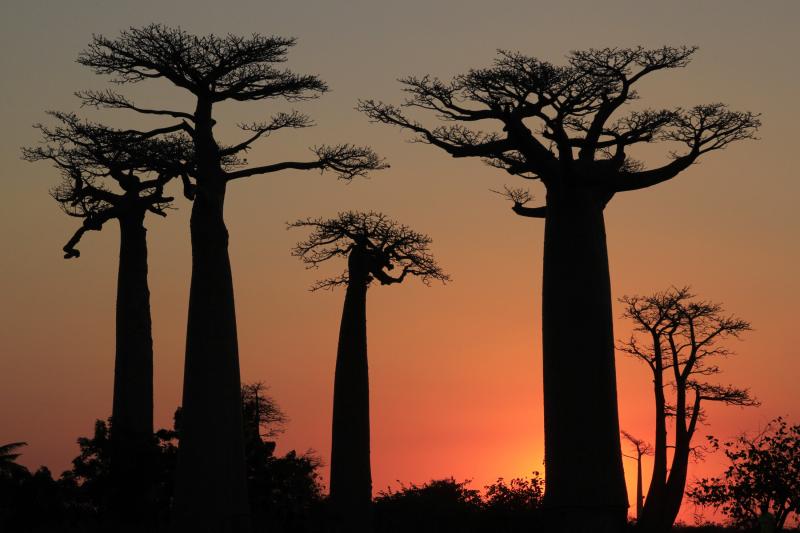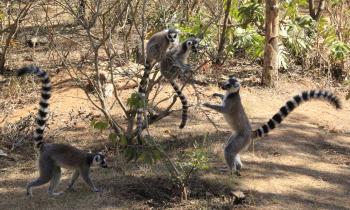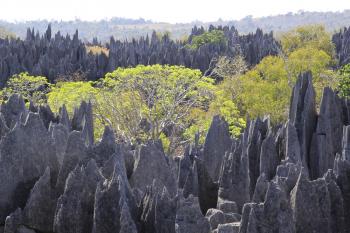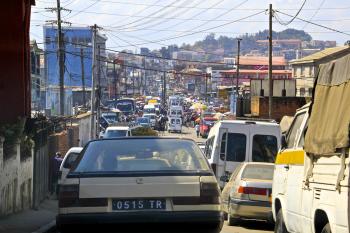Going mad for lemurs in Madagascar
This article appears on page 32 of the March 2019 issue.
I had traveled to over 75 countries, but Madagascar was still on my "to see" list, so I decided to go in August 2018. It is not the easiest country to visit — the distances between the national parks (and their very cute lemur inhabitants) are long, and the roads are not in good shape — but I would still recommend Madagascar if you like adventure travel. The lemurs are amazing, and I found the people to be very friendly.
Arriving in Antananarivo
Most visits start in Antananarivo (Tana for short), the capital of Madagascar, but I wouldn't spend much time there, as the pollution is bad, the traffic horrendous and the poverty very present. Also, I was constantly warned about pickpockets there, so I left my camera and extra money in the hotel when I went out walking.
There are two sights near Tana worth seeing: Lemur's Park, which has groups of about four lemur species that you can get very close to, and the King's Palace, part of a royal complex where the former king lived in the 17th century. Both are outside the city, and a round-trip taxi ride will cost $40-$50 plus the entry fee and a tip for the local guide.
The Queen's Palace in Tana was being renovated and is skippable, in my opinion.
There are some good craft shops, including the Pochard Artisan Market, near the downtown area, and the Lisy Art Gallery and adjacent stores, farther away from the center.
French influence can be found in the food in Tana, with many excellent, affordable restaurants available (dinners $10-$12).
Heading out
Many tour companies offer trips to Madagascar, but I chose G Adventures (Toronto, Ontario, Canada; 800/676-6230, gadventures.com) for my 20-day trip, as it seemed to offer the most comprehensive itinerary, at a total cost of $3,600, not including airfare. G Adventures also stresses having good guides, and mine, Kiady, was an affable and excellent one.
The trip started in Tana at the Chalet des Roses hotel, and I stayed after the tour at the Sakamanga (Blue Cat) Hotel. I would highly recommend either one for their locations, affordability, accommodations, excellent restaurants and friendly, helpful staffs.
I met the group of 16 fellow travelers for dinner on the first day of the tour, and we left Tana the next morning. Our itinerary would have us first heading east, then going in a giant sweep to the south, stopping for one or two nights at various national parks and ending at the beach at Ifaty in the southwest before flying back to Tana.
Traveling east from Tana in our comfortable bus, our first stop was Andasibe National Park, where we saw and heard the indri, the largest lemur species, as well as other lemurs, chameleons and geckos. On our night walk, the cute Goodman's mouse lemur, which would fit in a cup, was the highlight.
The next day's hike featured a diademed sifaka, and I decided that in my next life I would like to be a lemur or a sifaka to be able to jump with ease from tree to tree!
For photography, I would recommend a 300mm lens, though some lemurs cooperated and got quite close for some portraits.
Lemurs abound
The next day, we had a long, 8-hour drive (with a few stops on the way) via Tana to an overnight in Antsirabe. There were no nearby parks, but G Adventures had arranged with a progressive project in Fiadanana for us to hike to their village, where they have a dorm and food for travelers. They use the funds raised to improve the local villages.
It was a win-win for all involved, as we got to experience village life and the villages benefited (such as getting a beautiful new school).
Although many of the trip's drives were long, lasting five to eight hours, we had multiple stops along the way, some at handicraft workshops that were interesting. One participant took along collapsed soccer balls (easily blown up), which she gave away to various groups of kids we saw playing along the way.
Needing a lemur "fix," we headed south again to the Ranomafana rainforest for a night walk, seeing the even smaller brown mouse lemur. A day walk the next day offered views of more lemur species, chameleons and a mongoose! Luckily, there was a hot spring nearby where we could ease our tired legs. Not enough lemurs yet, so we stopped at the community-operated Anja Reserve, where we watched ring-tailed lemurs play not more than 10 feet away.
The first two weeks of the trip ended at the beach at Ifaty, where we had two lovely days to relax on the beach or at the hotel pool or to take optional trips for snorkeling and/or whale-watching for humpbacks traversing the Mozambique Channel. It was a well-deserved rest after our strenuous long drives and hikes!
Generally, I was surprised by the variety of terrain in Madagascar, with its wet eastern side and a mountain range that runs down the center and blocks the rain from reaching the dry western side of the island. I'd definitely recommend traveling in our summer, their winter, as the weather was generally pleasant (70°-80°F). It got warm during the day, but it would be scorching during their summer season.
A challenging finish
The group then flew back to Tana. Upon reflection, I should have chosen to go home at that point, like some others in the group had done, but, not wanting to miss anything, I had signed up for a third week in Morondava.
The day started off well, with a sunrise view of the Avenue of the Baobabs, but that was followed by a 9-hour drive on dusty, rutted dirt roads leading to the UNESCO World Heritage-listed Tsingy volcanic rock formations, featuring sharp, pointed edges. If you think that sounds dangerous, you're right.
We first explored the Petit Tsingy, but that only gave me confidence to climb the Gran Tsingy, which is definitely a challenge unless you're an experienced rock climber (or perhaps you have a death wish). Somehow I survived, and I was rewarded with a sunset view of the Avenue of the Baobabs on the return drive (on the same dusty, rutted dirt road) to Morondava.
The entire tour ended in Morondava, and the group flew back to Tana for various plane connections. With one free day scheduled before my departure, I decided to book a taxi to take me to the King's Palace outside Tana, and it was well worth the trip.
The taxi driver, Tiana, was recommended by friends. He was a lovely person and spoke English well enough to have discussions about local politics and the economy in Madagascar.
He is hoping to earn enough money to buy a 4WD vehicle so he can take travelers off the beaten track, and I so was impressed by him that I wanted to include his contact information (tianamada06@gmail.com) for those who might be interested in a private or semiprivate tour.
After observing and talking with various people I met along the way, I surmised that the political, economic and environmental situation in Madagascar is a mess. Madagascar has natural resources, such as ample water for irrigation, and could perhaps be a rich country, but the people generally seem to be very poor, with an average per capita income of less than $2 per day.
The problems seem to stem from corrupt government officials who pocket the country's income instead of providing resources for the people, so the roads remain in poor shape, and education is minimal. It's a sad, multifaceted issue.
However, I am very glad I visited Madagascar. It's a unique and special place, with lovely people, and I would recommend a trip. In our summer. And beware the Tsingies!




